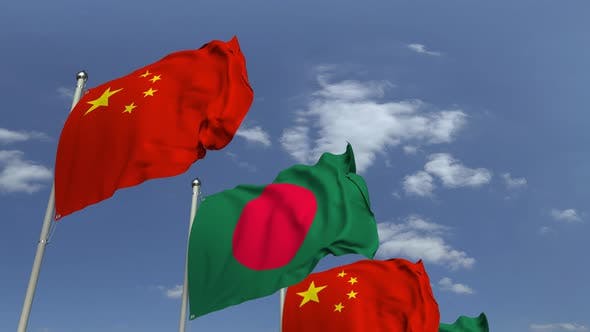Bangladesh and China share bilateral relations based on mutual interests and opportunities. This relationship is becoming firm with increased stability and continuity. According to Chinese government designations, Bangladesh and China are in a “strategic partnership of cooperation”.
Nevertheless, Beijing’s insecurities on the Quad, the India aspect and the trade deficit are creating tensions in the Sino-Bangladesh relationship. Last year, the countries celebrated the 45th anniversary of the establishment of diplomatic relations with a promise to further deepen their friendship and partnership. An enemy of yesterday is a friend of tomorrow is applicable for China as it was against the independence of Bangladesh in 1971, but now it has become an integral part of our development.
China has become Bangladesh’s largest trading partner, and Bangladesh has become China’s second-largest trading partner in South Asia. The trade bar between Bangladesh and China has broadened significantly in recent years. However, there are huge trade imbalances with China since 1974.
This trade deficit compelled Bangladesh to be immensely dependent on China and resulted in serious concerns about the economic, financial, and political impacts. According to reports, Bangladesh’s total exports to China from 2014 to 2021 grosses an average value of US $10, 094 million. In January of 2021, China exported $1.76 billion and imported $90.6 million from Bangladesh, resulting in a trade balance of $1.67 billion. Between January 2020 and January 2021, the exports of China have increased by $60.8 million (3.58%) from $1.7 billion to $1.76 billion, while imports increased by $25.6 million (39.3%) from $65.1 million to $90.6 million.
China’s investment in Bangladesh is very significant. The country committed to investing US $1.9 billion toward coal plant expansions and another US $5.1 billion in funding, for a total of around US $7 billion for about 14 GW of capacity. China invested US $10 billion on various infrastructure projects, which include the Chinese Economic and Industrial Zone, the 8th China Bangladesh Friendship Bridge, the International Exhibition Center, the US $3.3 billion bridge over the Padma River, and other US $1 billion on projects to improve digital connectivity. There is also a US $1.32 billion project to strengthen Bangladesh’s power grid network.
97% of Bangladeshi products are likely to enjoy duty-free facilities from Bangladesh to China as the country falls under the LDC category. Bangladesh’s major export items to China include apparel goods, jute and jute products, plastic products, live and frozen fish, and crabs. Despite these being duty-free, exports have not boosted. Economists have opined that there was a shortage of a diversified products basket. In addition, Bangladesh is in great need to acquire marketing skills. According to The Bangladesh Garment Manufacturers and Exporters Association (BGMEA), ready made garments (RMG) products worth $20 million out of $198 million would be included in the latest duty-free scheme. So this is certainly a diplomatic victory in the form of charity.
According to reports, China has pledged an investment of US $38 billion in Bangladesh for its Belt and Road Initiative (BRI) projects. The outcome will depend on how Bangladesh plans and executes these projects. There is some apprehension in Bangladesh that, with Chinese soft loans, Bangladesh will become the next Sri Lanka. Bangladesh’s total external debts are less than 15% of its GDP, which is far from the danger mark. Bangladesh also took the bold decision when, instead of a soft loan, it took a China-proposed commercial one. As a result, it did not allow Chinese investment in the Sonadia deep-sea project, avoiding a future Chinese Navy presence, and only agreed to a port project in Payra.
As reported by The Sunday Guardian Live, there is a lot of tension between China and Bangladesh over why the latter revealed the price of the Covid-19 vaccine. Here, Bangladesh clarified by saying that in a democratic country, nothing can be hidden.
There was also a point of contention over China’s warning to Bangladesh against joining the Quad alliance. China was perplexed as it recognizes Bangladesh’s strategically important geographic location and proximity to the Bay of Bengal, which increases its importance significantly in the unfolding geostrategic and geopolitical equations in the Indo-Pacific. Bangladesh delivered a strong reply to China by suggesting that it does not welcome any interference in its internal matters.
With regards to the Rohingya refugees, it is stated in Relief Web, “China reaffirmed its support for repatriation, and said it is ready to continue to engage in good offices, support enhanced dialogue between Myanmar and Bangladesh, and play an active role in accelerating the repatriation.” However, until it really happens, Bangladesh is not ready to entrust either China or Myanmar.
China is Bangladesh’s all-weather friend which is clearly unacceptable for India. The Quad is a dilemma for Bangladesh as it is difficult to choose a camp between the two mighty neighbors. China’s US $1 billion loans for the Teesta project are further fueling the rivalry between it and India.
Bangladesh, being in a strategic geographical location between South and Southeast Asia, has a domestic consumption potential and the wealth of its natural resources is a model for the developing world. It is also an emerging regional connectivity hub. Bangladesh is already being called the next China. Therefore, to become like China, Bangladesh is required to balance its present relations with China.
*The author is a school teacher, who exhibits interest in international politics. She often writes poetry.
July 15, 2021
The viewpoints expressed by the authors do not necessarily reflect the opinions, viewpoints and editorial policies of Aequitas Review.


